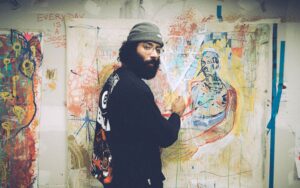February 9, 2018; The Crimson
After nearly 400 years, Harvard University has hired its first tenured professor of Native American studies. This is an important step in recognizing the university’s colonial roots and its obligations to Native American communities; hopefully, it’s the beginning of a more robust effort.
Philip J. Deloria is a member of the Standing Rock Sioux tribe and the son of Vine Deloria, a scholar, writer, and activist for Native American rights who earned national recognition for his 1969 book, Custer Died for Your Sins: An Indian Manifesto. Philip Deloria won acclaim for his book Playing Indian, in which he posits that “imagining Indians has helped generations of white Americans define, mask, and evade paradoxes stemming from simultaneous construction and destruction of these native peoples. In the process, Americans have created powerful identities that have never been fully secure.” Deloria is now a full tenured history professor in Harvard’s Faculty of the Arts and Sciences.
Truman M. Burrage, president of Native Americans of Harvard College, called Professor Deloria’s appointment “incredible,” but also “way overdue.” Harvard University Native American Program (HUNAP) Executive Director Shelly C. Lowe said, “Having a full professor here will legitimize Native American studies coursework here in a way that assistant professors just couldn’t.”
Though Harvard owes a significant debt to indigenous Americans, its programs and focus on Native studies currently leave something to be desired, according to students and faculty. HUNAP is not a recognized academic department, but an initiative run through the Provost’s office. The two Native American studies junior faculty who were hired in 2005 eventually left for other universities—Tessa L. Desmond, the Administrative Director for the Committee on Ethnicity, Migration, and Rights, cited a lack of mentorship as reason for their departure.
Like Harvard, Dartmouth’s mission included the education of Native students. Rev. Eleazar Wheelock, a congregational minister from Connecticut, received a charter from King George III and founded the college in 1769 “for the education and instruction of Youth of the Indian Tribes in this Land…and also of English Youth and any others.” However, as its own website admits, “During the first 200 years of its existence…Dartmouth fell far short of its educational goal, and a mere 19 Native Americans graduated from the College.” However, in 1970, newly inaugurated president John G. Kemeny pledged to redress the historical lack of opportunities for Native Americans in higher education. In recommitting Dartmouth to its founding purpose with a new focus on equity and inclusion rather than colonization, “John Kemeny established a Native American Program at the College and directed the Admissions Office to begin actively recruiting Indian students for the very first time.” Today, Dartmouth has a full Native American studies department with several full-time faculty devoted to tribal research, guest scholars, symposia, and even an alumni event specifically for Native alums. In this way, Dartmouth is far ahead of most other educational institutions, but it is hoped that Deloria’s appointment is a sign that Harvard may follow suit.
Dartmouth has the highest proportion of Native students in the Ivy Leagues, at four percent; in contrast, Harvard’s student body is 0.5 percent Native, making indigenous peoples underrepresented there compared to the general population, which is 1.2 percent Native. The University of Pennsylvania had a Native department chair in 1913, and has an outreach residential program that connects students with local tribal communities.
Sign up for our free newsletters
Subscribe to NPQ's newsletters to have our top stories delivered directly to your inbox.
By signing up, you agree to our privacy policy and terms of use, and to receive messages from NPQ and our partners.
As NPQ noted last year, the Ivy Leagues and other universities are attempting to come to terms with the racial injustice that is an unavoidable part of their legacies, and slavery is not the only injustice in which they were complicit. Harvard University, like the rest of Boston and Cambridge, was built on Wampanoag and Massachusett land. Once, 12,000 Wampanoag lived in New England, but today 3,000 of them live on a reservation on Martha’s Vineyard. Their language became extinct in the 19th century, though activists are attempting to revive it based on texts.
The Harvard Charter of 1650 dedicates the school to “the education of the English and Indian youth.” According to the Peabody Museum of Archaeology and Ethnology at Harvard University,
Harvard struggled financially soon after its 1636 inception. To support the faltering college, the English Society for the Propagation of the Gospel in New England (SPGNE) raised and granted funds for Indian education at Harvard. The College, in turn promised to waive tuition and provide housing for American Indian students….The Indian College’s founders hoped graduates would proselytize their home communities with the Gospel.
Like so many institutions, the Indian College was a tool for colonization of native peoples, not for studying the languages and culture. After it failed to generate a significant Native student body, it was disbanded and torn down, though not before printing a Bible in the Massachusett language. Quartz notes that “Harvard, Yale, and Brown continued for a long time to be powerful institutional forces in evangelizing native Americans.”
Today, Harvard still struggles to make Native studies a major part of its curriculum. It does not have a formal system in place to administer Native language tests, making it difficult bordering on impossible for Native languages to count for the undergraduate foreign language requirement. (NPQ reported recently on the issues activists confront when trying to revive or legitimize languages destroyed by colonial practice.) The Oneida nation endowed a visiting professor chair in the law school, but its current occupant, Robert T. Anderson, says there is enough student interest in American Indian Law to fill more classes than are currently offered in the field.
Deloria said, “There’s no institution that has any kind of clean history with Native America, but that doesn’t mean that institutions aren’t capable of redemption. To me, it seems like there’s a lot of people at Harvard who are thinking about this and thinking about it in a good way, and that’s the first step.” Student activists like Kaipo Matsumoto and Kau’i Baumhofer and faculty like Blythe George have been pushing the university to provide more opportunities for Native-centered education, and the establishment of a fully tenured Native American studies professor signals a commitment to making those studies part of the school’s academic culture, which is a good first step.—Erin Rubin












